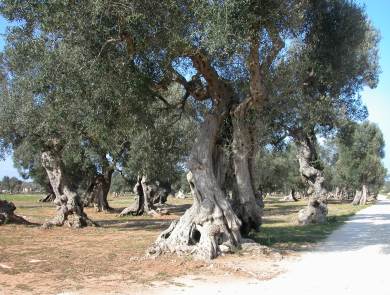
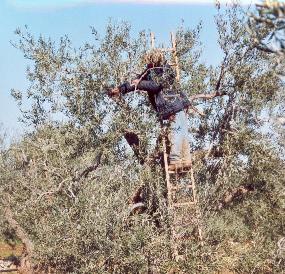
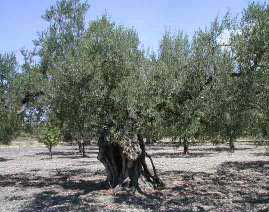
The origin of the olive tree is unknown. It is said to have appeared in prehistoric times, before humankind, and to have originated in Southern Asia Minor where there are now abundant forests of wild olive trees. It seems that it spread from Syria towards Greece by way of Anatolia, although other theories claim it originated in the Mediterranean basin.
Greece turns out to be the home, according to the myths, where the olive tree appeared first and was cultivated. Indeed, the legend attributes to Atena the merit to have donated this plant to the inhabitants of the Attica who, in turn , gratified the goddess making of the olive tree a sacred symbol of the same divinity and the city which was dedicated to her. It is told of exemplary punishments, the death or the exile, for those who cut an olive tree.
Starting from the VIII sec. B.C., with the Greek colonization of Southern Italy,
the cultivation of the olive tree was introduced in the Magna Graecia: the extraordinary
production and spread of the olive oil has been proved by the findings of pottery
and coins that testify the presence of the olive tree in that age.



Foto prese da www.sciacca.it
e da www.agriturismofrattavecchia.it
 Trebisacce
Trebisacce

Ř SPREAD OF THE OLIVE TREE IN ITALY
Some historians state that the olive tree has arrived in Italy during the period of Lucius Tarquinius Priscus (from 616 to the 578 B.C) the legendary king of Rome, although others sustain that it has arrived in Italy three centuries before the falling of Troy (at least 1200 B.C.). Once in Italy, it quickly spread from the North to the South, from Calabria to Liguria. The Romans spread the cultivation of this plant in all the colonized territories and the oil had a more and more substantial role in the general economy of the empire, so much that the production and selling of the oil were submitted to the direct control of the state.
Gaius Plinius II affirms that fifteen kinds of olive exist and he makes a list of all its virtues attributing to the olive tree an importance that is second only to the miraculous juice of grapes.
After the fall of the Roman empire, the production and trading of the oil suffer a dramatic crisis and it is only after the year 1000 that we assist to the resumption of its production thanks to the rich donations of olive groves given to the Church by Longobards, Normans, Swains and Angioins, and later it will be the Maritime Republics to give a new impulse to the international commerce of oil.
In the XIII century, the Venetians fix the price of oil: 3 dukedoms for 1000 pounds for the oil coming from Puglia and from Campania: 1 dukedom for 1000 pounds of other origin.
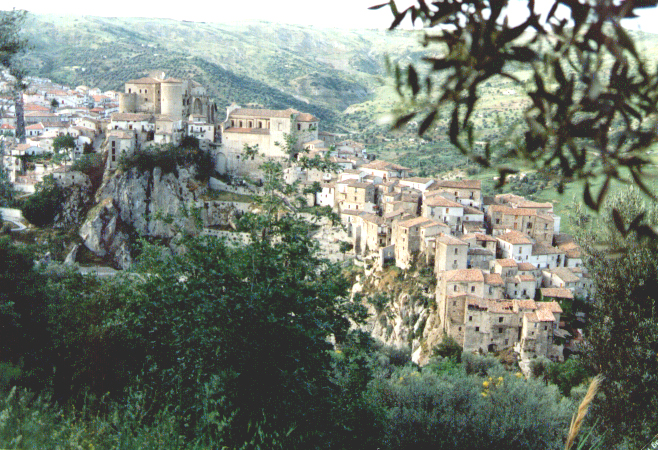
Oriolo, Medieval Castle
During the XIV century two schools of thought emerged as far as the condiments. From one hand the peoples of the North Europe who raised the pig , being the pig an animal from which they could get their daily nourishment and so making use of animal fat; from the other hand, in the South and particularly in Italy, the olive oil became the most used natural condiment for every type of dish.
In the XVIII century some experts started to catalogue the olive tree and its fruits and to classify its varieties according to the place of origin. In this century Liguria and Tuscany further define their vocation for the cultivation of the olive tree. In the XIX century the plantations of olive invaded Umbria destined to become for a long time one of the leading producers of olive oil on a long term.
Today, the extra virgin olive oil is produced in all the regions of Italy except in the Piedmont and Val d’Aosta. The leading producers are Liguria, Tuscany, Umbria and Apulia. In this last one there are 1/3 of all the trees present in Italy today and there is a place, Bitonto, that is known as the" city of the olive trees"
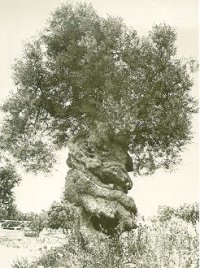
Taken from www.sciacca.it

Ř THE OLIVE TREE AND ITS LINKS WITH RELIGION
The olive tree has always been considered as a symbol of abundance, glory and peace. In the Old Testament it is mentioned when Noah sends a dove on a mission to find dry land after the Flood , and the dove comes back to the ark with an olive leaf in her beak, announcing the retreat of the waters from the earth in the olive groves located in the area of what is now Mount Ararat in Western Turkey. In both, Old and New Testaments, as well as in the Koran and Torah, all promises, admonitions, precepts and prophecies, frequently refer to olive trees which is not surprising since they were considered indispensable and vital for people’s health and sustenance. The Promise Land, the land of the Hebrews, is described as the country of wheat, barley, grapes, pomegranates, olives, and honey. King Salomon and King David placed great importance in the cultivation of olive trees. King David even had guards watching over the olive groves and warehouses to ensure the safety of the trees and of oil which was used for commerce.
Prophets often warned the population to behave or God would punish them either destroying the olive trees, or by making them produce bad olive oil. The Jews first and after the Christians began to use olive oil to anoint kings, priests and believers. In fact the word “Christ” means “ anointed”.
And it is always the oil that is placed on the forehead with the sign of the cross when one is christianized or when he passes away.
Nowadays, the olive tree is still considered sacred, mysterious and mythical, a majestic tree that can survive thousands of years and watch history fly by.
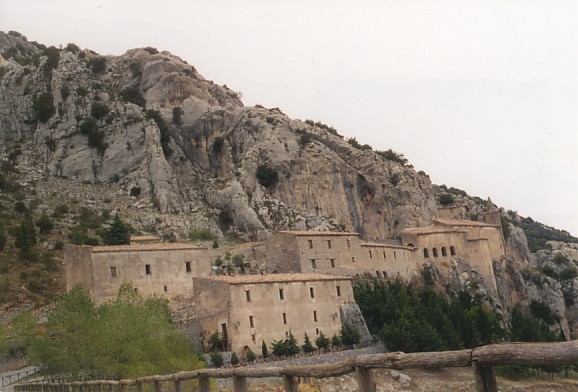 |
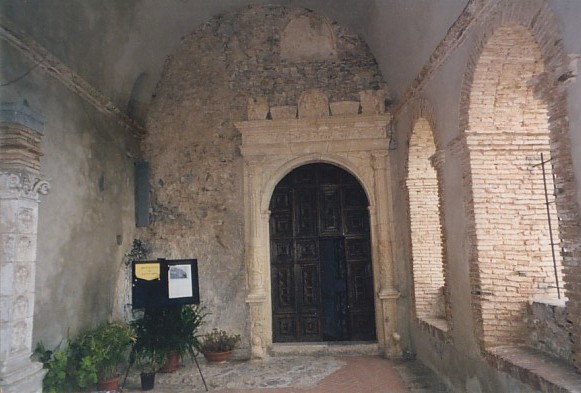 |
Santuary of "Madonna delle Armi"
in Cerchiara (CS) |

Ř OLIVE OIL IN COSMETICS
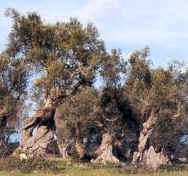 Ancient
Greeks an Romans used to use olive oil to take care of their bodies. Almost
every man and woman, young or old, sick or healthy, rich or poor used it a few
times a day. Oil was spread all over the body before and after bathing. At first
it had the same function of the soap but later it was used as a moisturizer
enriched with aromas obtained from herbs and flowers. People with dry hair and
skin were considered dirty and that’s why people bathed and moisturized their
bodies with oil at least once a day to keep a healthy appearance. Egyptians
manufactured perfumes and ointments of all types and Cleopatra was known
for using a great variety of perfumes and cosmetics. Many of them used olive
oil as a base, usually from colourless, tasteless, unscented olives picked well
before they were ripe (about three months earlier) in the month of August. The
body care also had a practical reason: oil forms a protective film over the
skin shielding the pores from infiltrations of dirt and dust.
Ancient
Greeks an Romans used to use olive oil to take care of their bodies. Almost
every man and woman, young or old, sick or healthy, rich or poor used it a few
times a day. Oil was spread all over the body before and after bathing. At first
it had the same function of the soap but later it was used as a moisturizer
enriched with aromas obtained from herbs and flowers. People with dry hair and
skin were considered dirty and that’s why people bathed and moisturized their
bodies with oil at least once a day to keep a healthy appearance. Egyptians
manufactured perfumes and ointments of all types and Cleopatra was known
for using a great variety of perfumes and cosmetics. Many of them used olive
oil as a base, usually from colourless, tasteless, unscented olives picked well
before they were ripe (about three months earlier) in the month of August. The
body care also had a practical reason: oil forms a protective film over the
skin shielding the pores from infiltrations of dirt and dust.
Nowadays, olive oil is still used in the manufacturing of soaps, nourishing and anti-wrinkle creams, shampoos, bath-foams, sunbath skin lotions, ointments.


--- Top ---
Trebisacce, a land to discover Mediterranean Diet